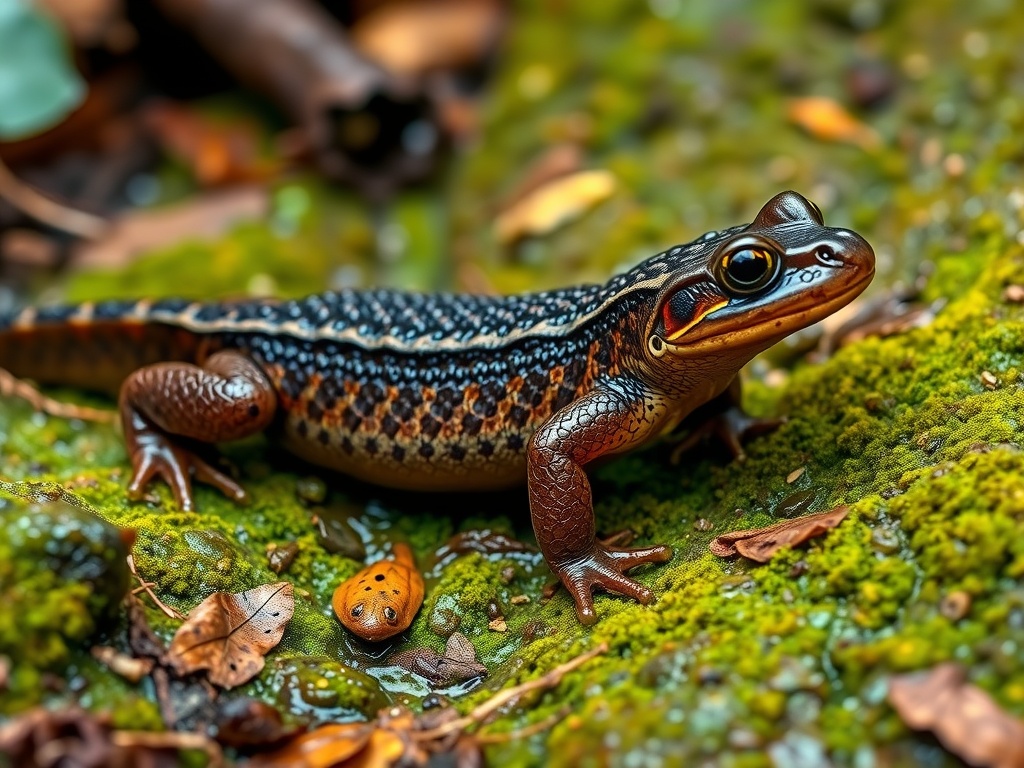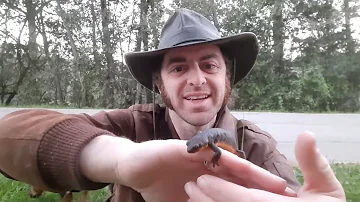
California Newt
Taricha torosa

Meet the California Newt
The California newt is a medium-sized amphibian native to California, recognized by its rough, warty skin and striking orange to brown coloration. It inhabits moist woodlands, chaparral, and forested areas, especially near streams and ponds during the breeding season. The newt is well adapted to both terrestrial and aquatic environments and is known for its potent skin toxin, which deters most predators. During the dry season, it retreats to moist refuges, becoming terrestrial until the rainy months trigger its migration to breeding pools.
Classification
Amphibian
Habitat
Moist woodlands and forests near streams and ponds
Diet
Carnivore
Lifespan
10-15 years
Conservation
Near Threatened
Weight
7-20 grams
📖Fascinating Facts
Toxic Defense
California newts produce tetrodotoxin, one of the most potent natural neurotoxins, making them highly toxic if ingested.
Dual Lifestyle
They live on land for most of the year but return to water bodies to breed during the rainy season.
Predator-Prey Arms Race
Garter snakes in their range have developed resistance to the newt’s toxins, resulting in an evolutionary arms race.
📋Detailed Description
The California newt (Taricha torosa) is a robust, medium-sized salamander, typically measuring 12–20 cm (5–8 in) in total length. Adults display a distinctive granular, warty dorsal skin ranging in color from brown to dark olive, while the ventral surface is a vivid orange to yellow-orange, serving as a warning to potential predators. Their heads are broad with prominent eyes, and they possess well-developed limbs with four toes on the forelimbs and five on the hind limbs. California newts are primarily terrestrial outside of the breeding season, seeking shelter under logs, rocks, or leaf litter in moist environments. During the rainy season, they migrate en masse to aquatic habitats for breeding, often returning to the same pools each year. Their movement is slow and deliberate, and they rely heavily on chemoreception to navigate and locate prey. The skin secretes tetrodotoxin, a potent neurotoxin, making them highly unpalatable and providing defense against most vertebrate predators. Larvae are aquatic, with external gills and a more cryptic coloration, and undergo metamorphosis before transitioning to a terrestrial lifestyle. The species is long-lived, with individuals known to survive over 20 years in the wild.
💡 Did you know?
Despite their toxic skin, some garter snakes have evolved resistance and are one of the few predators capable of eating California newts.
🔬Research & Sources
Wikipedia Summary
The California newt or orange-bellied newt, is a species of newt endemic to California, in the Western United States. Its adult length can range from 5 to 8 in. Its skin produces the potent toxin tetrodotoxin.
Last Modified: 5/25/2025
🎭Behavior & Social Structure
California newts are largely solitary outside the breeding season, exhibiting crepuscular or nocturnal activity patterns, though they may be active during the day in moist conditions. Their hunting strategy involves slow, methodical foraging along the forest floor or in aquatic habitats, preying on small invertebrates such as insects, worms, snails, and aquatic larvae. Feeding is accomplished via a rapid tongue projection to capture prey. During the breeding season, males become more aquatic and may display increased aggression or competition for access to females. They exhibit homing behavior, often returning to the same breeding sites annually. When threatened, the newt adopts an 'unken reflex,' arching its back and displaying its bright ventral coloration as a warning. Social interactions are minimal, though temporary aggregations occur during migration and breeding.
👶Reproduction & Life Cycle
Breeding occurs from late winter to early spring (typically December to May, depending on rainfall and elevation). Males arrive at breeding pools first and develop nuptial pads on their hind limbs to aid in grasping females. Courtship involves a series of tactile and chemical cues, with the male clasping the female in amplexus. Fertilization is internal; the male deposits a spermatophore, which the female picks up with her cloaca. Females lay 7–30 egg masses per season, each containing 7–47 eggs, attaching them to submerged vegetation or rocks. Embryonic development lasts 14–52 days, depending on water temperature. Larvae remain in the water for 3–6 months, feeding on small aquatic organisms before metamorphosing into terrestrial juveniles. There is no parental care post-oviposition.
🛡️Adaptations & Survival
The California newt's most notable adaptation is its production of tetrodotoxin, which is concentrated in the skin and serves as a powerful chemical defense. This toxin is lethal to most vertebrate predators, with the exception of some garter snake populations (Thamnophis spp.) that have evolved resistance, leading to a well-documented example of coevolution. The newt's aposematic (warning) coloration enhances predator avoidance. Its granular skin helps reduce water loss during terrestrial phases, and the ability to aestivate in moist refuges allows survival through dry California summers. Homing behavior and site fidelity to breeding pools increase reproductive success. The newt's dual life cycle (aquatic larvae, terrestrial adults) allows exploitation of different ecological niches.
🎨Cultural Significance
While the California newt does not have a prominent role in indigenous mythology or folklore, it is recognized as an important indicator species for healthy aquatic and terrestrial ecosystems in California. Its striking appearance and unique toxin have made it a subject of interest in educational and scientific contexts. The species is sometimes featured in local conservation campaigns and is protected under California state law from commercial collection.
🔬Recent Research & Discoveries
Recent research has focused on the coevolutionary arms race between California newts and their garter snake predators, providing insights into evolutionary biology and toxin resistance. Studies on population genetics have revealed significant genetic structuring across the species' range, suggesting limited dispersal and the importance of habitat connectivity. Ongoing monitoring assesses the impacts of chytrid fungus and climate change on population viability. Conservation efforts are increasingly using environmental DNA (eDNA) to detect newt presence in breeding habitats, improving survey efficiency and accuracy.
🎥Wildlife Videos

Natural History of California Newts
CaliforniaNewt #Newt #NaturalHistory The California Newt is an interesting and fun amphibian that is endemic to California ...
A Birding Naturalist

Great Crested Newt Documentary
Documentary on the great crested newt and the work of Wildwood Trustee & Director of the Durrell Institute of Conservation ...
Wildwood Trust

Story of the Eastern Newt - A Nature Documentary
Welcome back to the Salamander Wilds! Your certified Herpetologist here, back with another video! This time, I explore the life of ...
The Salamander Wilds

Yosemite - America's Most Spectacular National Park | Free Documentary Nature
Yosemite - America's Most Spectacular National Park | Wildlife Documentary Watch 'Yellowstone - The Breathtaking Beauty of ...
Free Documentary - Nature

Extremely Poisonous Newt!
On this episode of Breaking Trail, Coyote and the crew hike into the redwood forests of Northern California in search of the ...
Brave Wilderness

Nature: Newts
"Sunday Morning" takes us to a Redwood forest and creek in Los Gatos, California, a quiet home for the humble newt.
CBS Sunday Morning
🌍Habitat Information
The California Newt typically inhabits Moist woodlands and forests near streams and ponds environments. California Newts have adapted to their environments with specialized features and behaviors.
Primary Habitat:
Moist woodlands and forests near streams and ponds
More detailed habitat information will be available soon.
🛡️Conservation Status
The California Newt is currently classified as Near Threatened. Conservation efforts are crucial for preserving this species for future generations.
Common Threats:
- 🏠Habitat loss and fragmentation
- 🌡️Climate change impacts
- 🎯Hunting and poaching
- 🏭Human-wildlife conflict
⚠️Threats & Conservation Challenges
Major threats to the California newt include habitat loss and fragmentation due to urbanization, agriculture, and infrastructure development. Prolonged droughts, exacerbated by climate change, reduce breeding habitat availability and larval survival. Invasive species such as crayfish and predatory fish (e.g., mosquitofish) prey on eggs and larvae. Disease, particularly chytridiomycosis caused by the chytrid fungus (Batrachochytrium dendrobatidis), poses a significant threat to populations. Road mortality during seasonal migrations and pollution from pesticides and fertilizers further impact local populations. Although still relatively widespread, population declines have led to its Near Threatened status on the IUCN Red List.
🔬Scientific Classification
Scientific Name
Taricha torosa
Classification Hierarchy
🔍 About Taxonomic Classification
Taxonomic classification is a hierarchical system used by scientists to classify and organize living organisms based on shared characteristics and evolutionary relationships.
The system moves from broad categories (Kingdom) to increasingly specific ones, with each animal's scientific name typically consisting of its Genus and species.
📝Community Notes
Share your observations and insights about the California Newt with our community of wildlife enthusiasts.
Join Our Community
Sign in to share your observations and connect with fellow wildlife enthusiasts.
Sign In to ContributeNo community notes yet
Be the first to share your observations about the California Newt!
Explore California Newt
Select a tab above to learn more about this amazing animal.
📸Photo Gallery
No photos available for this animal yet.
🌟Discover More Wildlife
Continue your journey of discovery with more fascinating animals from our database
